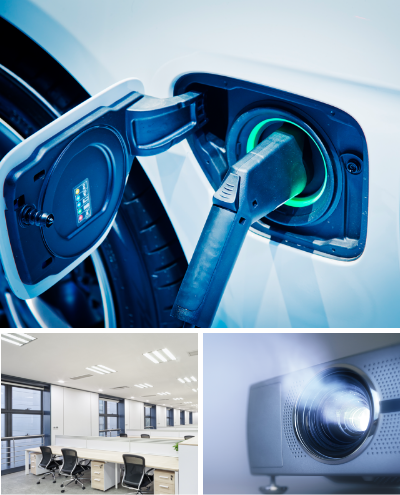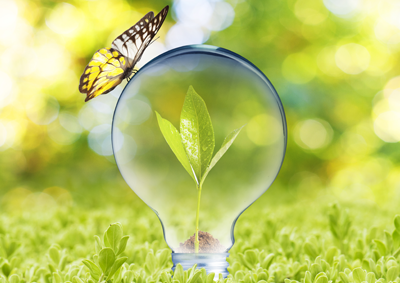Nichia's History
Challenge and Pursuit of True Nature
That is the NICHIA Way
1956Founding
Nichia's founder, Nobuo Ogawa, was a graduate of the pharmaceutical chemistry department of Tokushima Technical High School (the predecessor of Tokushima University). After WWII, he established the “Kyodo Pharmaceutical‑Laboratory,” the predecessor of Nichia, with a strong desire to contribute to the reconstruction of his hometown, Tokushima. From this new research institute, he established the production system for anhydrous calcium chloride used for streptomycin, a treatment for tuberculosis by utilizing limestones mined in Tokushima which would lead to the development of anhydrous calcium phosphate, a raw material of phosphors for fluorescent lamps.
In 1956, under the new name of Nichia Kagaku Kogyo, K.K. (currently Nichia Corporation), this small company began its journey into the chemical industry with its phosphor raw material.

1966To be the World’s No.1 Phosphor Manufacturer
In 1966, through significant R&D and the combination of competencies with the phosphor raw materials, production of calcium halophosphate phosphors for fluorescent lamps began. The corporate culture of applying its technical competencies and developing them into a new product began around that time and has continued to this day.

1970Phosphors for color TVs
Color TVs had become widespread amid high economic growth.
Nichia started the production and sale of phosphors for color TVs by applying its technical competencies of phosphors for fluorescent lamps. During this period, Nichia’s team accumulated vast knowledge and experience of color and light that would later prove essential to the business.

1983Challenges for new businesses
Nichia went through many challenges to develop new products following phosphors.
In 1983, production and sales of GaAlAs (Gallium Aluminum Arsenic) epitaxial wafers for IR LED began which was the dawn of Nichia's opto-semiconductor business.
In 1989, R&D for Gallium Nitride based LEDs started by installing the first MOCVD (Metal Organic Chemical Vapor Deposition) equipment which would lead to creating the blue LED.
In 1991, R&D for the cathode materials for Lithium-ion secondary batteries began. During this period, the R&D of these products would become the basis for the primary business of Nichia in the coming years.

1993The blue LED that surprised the world
Nichia succeeded in developing the world's first high luminous blue LED which was believed to be impossible to achieve within the 20th century and started the volume production and sales. This blue LED, that was one hundred times brighter than anything before, surprised the world. In 1994, Nichia succeeded in developing a high luminous bluish-green LED which led to the LED conversion of traffic signals.
In 1995, Nichia developed a pure green LED which made it possible to make full-color displays by combining this green LED with high luminous blue and red LEDs that were already available in the market. Several larger full-color LED displays were installed around the world.
For more information on what was happening when the high brightness blue LEDs were launched and how the applications have expanded, visit the Blog.

1996The white LEDs that would eventually change the world
In 1996, Nichia developed the world's first white LED by combining a blue LED with yellow phosphor, utilizing the technology and experience that Nichia acquired through phosphor manufacturing. LED lighting, stylish LED headlights, full-color LCD display for smartphones, all these new products were developed and commercialized based on white LEDs developed by Nichia.

2001Violet LDs open a new world of opportunities
Nichia created a violet Laser Diode, which was believed to be more difficult to develop than a blue LED. In 1995, Nichia succeeded in creating this with pulsed operation, and then in 1997, achieved 10,000 hours of continuous wavelength operation. The volume production and sales started in 2001.
Nichia also contributed to the startup of a new generation of optical disk technology to succeed DVD.

2009Development of high-quality cathode materials for Lithium-ion batteries in automotive
Nichia started R&D on the cathode materials in 1991 and it was first adopted for use in consumer products in 1996. Then in 2009, it was adopted for automotive batteries, contributing to the development of electric vehicles (EVs).

2015High-quality magnets to support an automated society
Since 1992, Nichia has conducted R&D for magnets used in motors, specifically those essential for electric vehicles (EVs) and an automated society. Nichia’s SmFeN (Samarium Iron Nitrogen) based magnetic material has many unique properties such as strong resistance to rust. Magnets made with them have a high degree of freedom in shape and can be miniaturized. In 2015, it was adopted as a component for automotive due to its excellence shock resistance and heat resistance.

2019UV LEDs with expanding application fields
365nm UV LEDs commercialized in 2002 have been widely used for industrial applications such as exposure, ink printing, and others.
The 280nm deep UV LED mass-produced in 2019 is proven to inactivate bacteria/viruses and is expected to be applied in the field of sterilization.

For the FutureCreating the future with light and energy
Nichia will challenge various possibilities in the fields of light and energy.
For LEDs, Nichia is expanding its development of products by focusing on the "quality of light" and “function of light” as well as pursuing high brightness and low power consumption. For automotive applications, cutting-edge LEDs for headlights are expected to improve safety while driving. Laser Diodes are expected soon to be expanded into other applications such as lighting, processing, and heads-up displays for automotive.
Cathode materials for Lithium-ion batteries used in electric vehicles (EVs) and high-quality magnetic materials essential for small high-quality motors are key materials to realize a carbon-neutral society and will create a path towards using clean energy in the future.
Nichia will continue to make innovative products to create a bright future for the earth.

LED lighting is also illuminating the future of the global environment
White LEDs invented by Nichia, have been playing a key role in carbon neutrality. Together with UV LEDs and LDs, they are also making a significant contribution to the realization of a mercury-free society.
LED lighting can reduce power consumption to less than half compared to conventional light sources such as incandescent and fluorescent bulbs. By the 2030s, LED lighting is expected to replace most of the world's lighting. If this happens, more than 1 billion tons of CO2 emissions will be reduced compared to if conventional light sources had been used continuously. One billion tons per year is almost the same amount of CO2 emitted by Japan in one year.
LED lighting, with UV LEDs and LDs, will also make a significant contribution to the realization of a mercury-free society by replacing conventional light sources that contain mercury, such as fluorescent lamps, mercury lamps, and sodium vapor lamps.
For more information on Nichia's contribution to the realization of a mercury-free society, visit the Blog.


